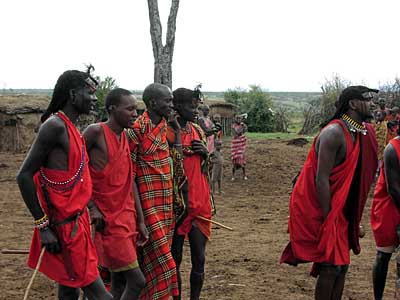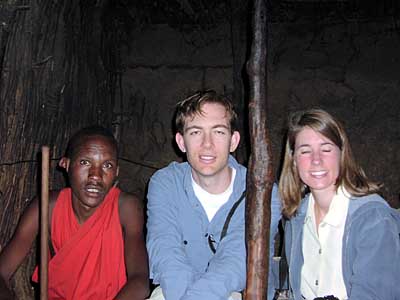
Cindy’s Journal
July 24
We woke up early after getting up several times with tummy troubles. The room was very chilly. It was very cold in the mountains. After dinner the previous evening, we had come back to our room to find hot water bottles. Lovely. We need to get these for home. We had breakfast and headed for Samburu. Four hours on dusty, very bumpy roads. We saw Muslim trader influence in Isiolo. People were willing to trade for pens so Dmitri was happy I had brought Bic pens even though he thought it was ridiculous when I packed them. 5 pens=a small wooden carving.

On the afternoon of July 24, we went for our first game drive in Shaba Reserve. It was very dusty and bumpy. Fred didn’t think it was so exciting, but we saw lots of things so we were pleased. We came back and were so exhausted that we went to bed early. The next morning we were up early for a long game drive at Buffalo Springs Reserve. We were gone from 7:30-12. We were constantly amazed at Fred’s good eyesight. Once again, dusty and bumpy. Fred says that he doesn’t like to take French people on game drives. He also is not fond of Italians. He told us that he saw some Italians shoplift from the curio shops. Later that afternoon we went back to Shaba again, but did not see much. But on both afternoon game drives, we saw roadblocks for Survivor and on the first day with binoculars we saw a big platform with lights. Fred’s guide friend says there are three people from each tribe left. It’s a cheap thrill for us.
On our first afternoon game drive, which Fred described as boring, we saw impalas alerted by a predator, but we didn’t stay to see what happened. The most we saw was the Survivor filming area in the distance. We saw a big lit platform and helicopters flying back and forth. They are filming in the area between a big mountain and the Uaso River. The Maasai name is the Cloud River. We had an early dinner for an early start the next day. We also saw a big croc at the croc feeding. On the long early morning game drive in Buffalo Springs, we saw all kinds of animals. My favorite was the gerenuk and we were lucky to see cheetahs and the reticulated giraffe (very lucky since this was the only area we were going where we could have seen the reticulated giraffe). Elephants, Cape buffaloes, and waterbucks became ho hum since we saw them everywhere we went. We got back hot and dusty and had tea later that afternoon with Fred and learned about him. He is a self-taught guide. The afternoon game drive was quiet; we didn’t see anything new.

July 27
We arrived at Siana Springs Tented Camp. The tents are kind of wild. They are permanent with beds and a bathroom. They are canvas and get very chilly even when zipped all the way up. We are, of course, the farthest tent out. That’s been our luck this safari—getting the room the farthest away and having to walk the most. Also, we keep getting twin beds on this trip which is pretty ridiculous. Anyway, we are told that there is no perimeter to our camp. Kind of creepy. Africa is very dark at night, especially if there are no lights in the camp. It was very, very cold at Siana Springs. The tented camp idea is a very neat concept and would be incredibly neat in warmer weather or if we didn’t need amenities. A good, hot shower after all the bouncing would be nice. Jumping safari, according to Fred. On our first drive in the Mara we saw lions and cubs playing. We also saw a cheetah. Kazillion wildebeest (gnu).
We feel very fortunate to have been here during the Great Migration. It takes place late July/early August when the herds move from the Serengeti to the Mara. In October they go back after they have eaten it clean.
We got to stop at a Masai village and felt like interlopers in a tourist trap but it was worth it to see how they live. They live in huts made by the women with branches and sticks which they then cover with cow dung to cement it together and keep out the rain. Women do everything. Men just hunt the lions and drink tea, according to Fred, who grew up Masai. The women sang a welcome song and the men showed us the jumping dance (they just jump up and down as high as they can) and how to start a fire using a piece of wood, metal, and cow dung.

At the lodge, they put out breadcrumbs and the bushbaby and genet cat come to eat. They had put hot water bottles in the bed, which we desperately needed. The staff is very friendly. They are eager to help and please. There are impalas walking freely around the tented camps as well as token vervets. It is weird seeing cats and dogs after all this. I am terrified of encroaching animals. The tents rustle and there are many animal noises in the night. The power is off from 12-5 am. I use candles throughout the night. It is too creepy otherwise. I do not get much sleep in Africa.
It is much hotter here. We are near where Survivor 3 is being filmed. We are in the same reserve at a nice resort. Once again, we were greeted with towels—this time they are cool—and juice. It is a long walk to room 80. We are by the river and it is a beautiful place. An oasis of water in a very dry reserve. There is a colorful diversity of birds on the hotel grounds. On the way in, we saw vervet monkeys and baboons and a big croc sunning himself in the river. The signs all say “Don’t get too close to the river.” We had a game drive with Fred that afternoon, watched the croc feeding in the evening and saw some Samburu dancers. We found out that the electricity is off from 3-6 pm and from midnight-4:30 am.
The place we stayed has a pretty 2nd floor open air restaurant overlooking the river. There are many birds flying around and the monkeys try to sneak into the restaurant and grab food from the buffet. There is man whose job it is to watch for the monkeys and shoot them with a sling shot if they try to grab the food. Vervet monkeys are very fast.

| We left the next day for a very long, very bumpy ride to Lake Nakuru. On the way, we stopped in Nanyuki to see weavers. We almost got stuck in the mud and had to stop for a flat and Fred had to change tires. Once we arrived in Lake Nakuru, the afternoon game drive was a success. We saw 2 leopards, which are really rare and hard to spot. Fred says this nearly insures seeing the Big 5 (lion, leopard, buffalo, elephant, and rhino). On the game drive, we parked right next to a white rhino. What a massive creature. We saw our second type of giraffe, the Rothschild’s giraffe. We saw a kazillion flamingos around Lake Nakuru. So many that from a distance it looks like a giant pink beach. Also on our game drive, we saw a carcass in a tree that Fred told us a leopard had eaten and then left behind. |



We went inside a hut. It was small and dark. There is a tiny separate area inside the hut for goats. We made the obligatory market stop inside the village. Good grief! There was a rush of people. We felt like we had to buy. I got 2 bracelets made of beans and beads. We also got a bowl (which turned out to be lopsided) and Dmitri got an elephant necklace. The Masai wear red shawls. If a man kills a lion, he doesn’t have to pay a dowry. Fred went on a lion kill with a group when he was 17. He told us that if you don’t go, you are considered a coward. He said he wasn’t the one who made the kill, but that’s ok. The village people showed us a pop you on the head stick—trying to sell it of course. All the people in the village are brothers and sister. They are the children of one head man. Masai Mara means dotted plain. Simba means lion.

 dmitri.usc@gmail.com
dmitri.usc@gmail.com